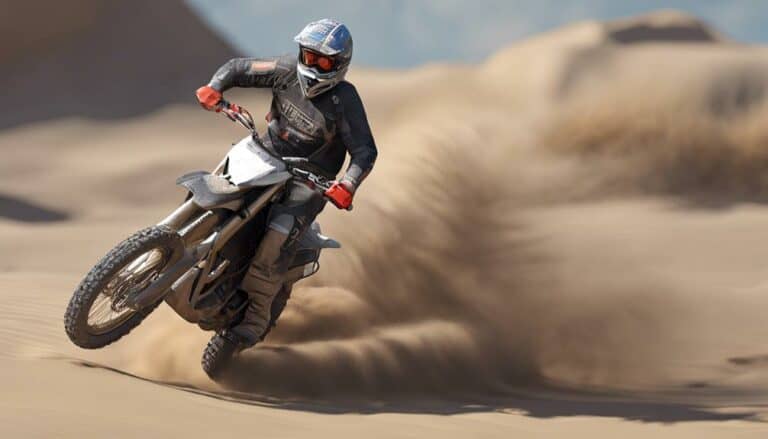When facing the sandy challenges on your off-road adventures, think of balance as your anchor in the shifting dunes. To enhance your stability and control in such conditions, mastering techniques like weight distribution, throttle modulation, and body positioning is key.
But what if there was a subtle yet powerful method that could revolutionize your sand riding experience, taking your skills to the next level? Stay tuned to discover this game-changing approach that will have you conquering sandy terrains with newfound confidence and finesse.
Key Takeaways
- Master balance through proper tire pressure and body positioning.
- Utilize leg strength for improved control and stability in sand.
- Learn techniques to escape tough spots and maintain momentum.
- Practice consistently to enhance skills, confidence, and muscle memory.
Importance of Balance in Sand Riding
To navigate sandy terrains successfully, mastering balance isn't just a skill but a necessity for off-road riders. When riding in sand, the rear wheel constantly shifts, requiring you to make quick adjustments to keep your bike stable. Proper tire pressure is essential as it affects how the bike interacts with the sand. Lower pressure increases the tire's footprint, improving traction, while higher pressure can cause the tire to sink, making control more challenging.
Your foot pegs play an important role in maintaining balance. They serve as your connection to the bike, allowing you to shift your weight and control the bike's movements. Placing your feet on the foot pegs correctly helps distribute your weight and stabilize the bike in sandy conditions. By adjusting your body position and utilizing the foot pegs effectively, you can enhance your balance and control, making it easier to maneuver through the shifting sands. Mastering these techniques will boost your confidence and skills when tackling sandy off-road terrains.
Utilizing Leg Strength for Control
When riding in sandy conditions, your leg strength becomes pivotal for maintaining control and stability on your off-road bike. Deep sand can be particularly challenging, requiring you to adapt your riding techniques to stay upright. By utilizing your leg muscles effectively, you can enhance your control over the bike and navigate through the sandy terrain with confidence. Here are some key ways to leverage your leg strength for better control while riding in sandy conditions:
| Technique | Description |
|---|---|
| Stabilizing the Bike with Your Legs | Gripping the bike firmly with your knees helps you maintain balance and prevent the front wheel from washing out. |
| Using Legs for Steering in Deep Sand | Shift your weight and use your legs to steer the bike through deep sand, keeping it upright and on track. |
| Absorbing Impact with Leg Flexibility | Flex your legs to absorb the vibrations and impacts when riding over bumpy terrain, enhancing stability and comfort. |
Techniques for Escaping Tough Spots
Utilize your momentum and strategic weight distribution to skillfully navigate and escape challenging spots in sandy terrains.
When facing sand dunes or getting stuck in deep sand, remember to keep up your speed to prevent sinking. Lean back slightly to reduce the weight on the front wheel, helping it float over the sand rather than dig in. Avoid sudden bursts of throttle that could cause your rear wheel to dig deeper into the sand.
If you find yourself stuck, refrain from excessive clutch usage as it can lead to a loss of control. Instead, consider pushing the bike with your legs to free it from tough spots.
Continuous Practice for Improvement
Enhancing your off-road riding skills in sandy conditions requires consistent and dedicated practice to improve balance and control. Keep in mind that regular practice sessions in sandy terrain are essential for honing your abilities.
The first thing you need to do is commit to practicing in varying sand conditions to adapt to different challenges effectively. Through continuous practice, you develop muscle memory that enhances your stability on the bike, allowing you to navigate the sandy terrain with more confidence.
Engine Management in Sandy Conditions
To effectively handle sandy conditions while riding off-road, maintaining continuous engine operation is essential for sustaining momentum and control. When riding a dirt bike in the sand, managing the engine differs from riding on regular terrain. Here are some key engine management tips to help you navigate sandy conditions successfully:
| Engine Management Tips for Riding in Sandy Conditions | Description | Importance |
|---|---|---|
| Avoid sudden stops on uneven terrain | Prevents getting stuck and losing balance | Maintains forward momentum and control |
| Maintain a consistent speed | Helps navigate sandy terrains effectively | Prevents getting bogged down in soft sand |
| Focus on the road ahead | Anticipate obstacles and adjust engine | Smoother riding experience, better control |
Conclusion
To sum up, mastering balance and control in sandy conditions is key for off-road riders. By implementing proper techniques and practicing consistently, you can navigate challenging terrains with confidence and skill.
Despite the initial difficulty, overcoming the fear of sand riding is achievable through dedication and perseverance.
So, next time you hit the trails, remember to stay focused, keep practicing, and embrace the sandy challenge head-on. Your improved skills will speak for themselves.

